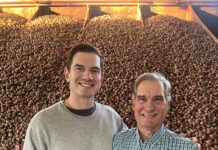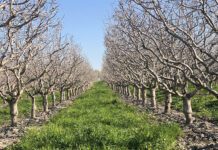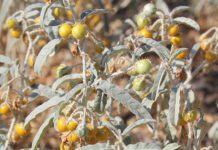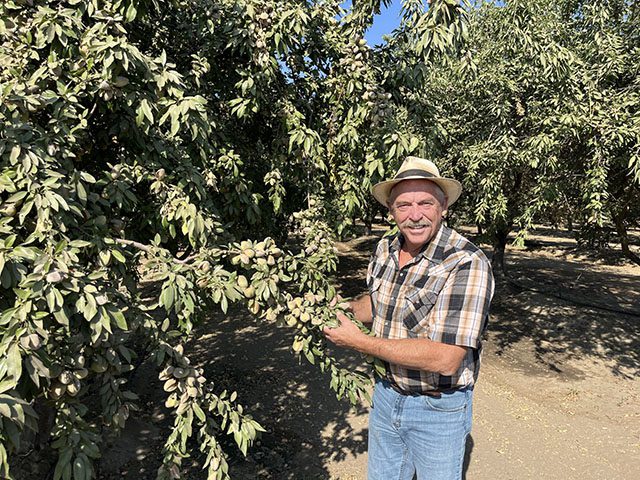
Listen to the audio version of this article. (Generated by A.I.)
Jamie Bledsoe of Golden Genes Inc. and Riverdale East Investors is somewhat of a rarity these days. He’s a first-generation grower of almonds, pistachios and winegrapes, but he didn’t start out growing anything from the ground. He spent his first 30 years working with dairy cows.
As an animal science graduate, he went to work on his soon-to-be-wife’s family dairy operation while he waited for her to graduate.
“I was working and just never left,” he says.
He made the switch from cows to almonds and pistachios because the market was profitable and the workload was less than on a dairy farm.
“I have four kids, three daughters, one boy,” he said. “All three girls married city boys, so none of them wanted to come back to the ranch. And my son and I, we looked at ourselves and said, ‘Why are we killing ourselves with these cows?’ even though we love the cows.”
Between the investor partnership and his home ranch, Bledsoe’s operation includes more than 500 acres of almonds and pistachios. In addition to growing tree nuts, Bledsoe custom harvests about 3,000 acres for other growers.
He shared his perspective with West Coast Nut on what it takes to be a first-generation grower as well as his thoughts on the state of the tree nut industry.
“I’m real excited about pistachios… I think we’re going to be in a sweet spot for a while, provided there’s no big economic shocks.” – Jamie Bledsoe, grower
Q. What is the history of your farming operations?
I consider myself a first-generation farmer, although I married a farm girl whose family is on their third generation. Initially, for 30-plus years, I was involved in the dairy business. And about 10 years ago, we decided to get out of the dairy business and converted everything that we were involved in into permanent crops: pistachios, winegrapes and almonds.
In our partnership, we farm about 460 acres of almonds and pistachios combined, and then our personal ground is 300 acres of winegrapes, pistachios and almonds. About an even mix or diversity. I love farming, and that’s what we do every day.
Q. As a first-generation grower, how did you get your start?
I guess you could say I married into it. My wife’s family helped provide the opportunity for us to go off on our own.
However, I really got started in 4-H and FFA. My enterprise projects were all in production agriculture. They included oat hay, swine production, sheep production and dairy. When attending Cal Poly, I worked on all the livestock units as well as the farm while attending classes. I paid for my college education with the profits from my enterprise projects. Those years really gave me a passion for producing food.
Q. Why did you choose tree nuts?
At the time we made the change to nuts because nuts became the best use of the land and resources. We were also involved in the development of 320 acres of pistachios in Five Points and really enjoyed working with the trees. Compared to all the other enterprises I’ve done in my life, pistachios are forgiving and easy to farm. In addition, they made the most sense in terms of profitability.
They’re really a super nutrient-dense product, so doing something you love with a tree you really like, and you’re producing a really good food and a real efficient way to move nutrient and protein around the world, that’s why I got into tree nuts.
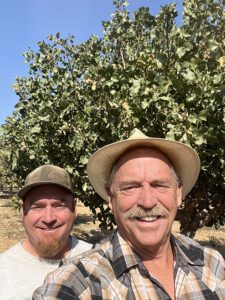
Q. How big of a shift was it from the animal side to growing tree nuts?
Not much. We always farmed, we always grew corn, wheat and alfalfa, so it was just that the pace is slower. You went from working 15- to 18-hour days down to 10 or 12, and now I’m sort of semi-retired. My son does all the hard work now.
But that was the biggest thing. You had a lot more time on your hands, so that was good for us because we were able to shift and really get in and learn how to farm them, and we had some experience in how to do things right. And how not to do things.
Q. Talk a little bit about that learning process. What were the resources that you used?
I used the articles and research at the UC websites. I used consultants, and I used farmers. We have consultants that are way better at doing this than I am, but that’s how we learned. We use their advice and then put it to good use.
I’m involved with most of the organizations, but for example, with the American Pistachio Growers, you get to rub shoulders with other farmers and kind of figure out best practices on what might work in your soil. That was our learning curve, and over time, you just have to go do it.
You have to pick up a shovel, and you have to get dirty and muddy and sweaty. That’s how I learn. You learn the mistakes, and you don’t do them again.
Q. How have you seen farming practices change over the time you’ve been growing nuts?
Particularly in almonds, you really have to figure out how you can cut costs, and it’s very difficult to cut costs per acre when most of the things you’re doing have to be done if you’re farming right. So, you have to pick and choose a little bit more. Just in the 10 years I’ve been farming pistachios and winegrapes, we’ve gone to more mechanization to offset labor costs, mechanical pruning, driverless equipment and automated irrigation systems. We are also using minimum or no-till, cover crops and composting.
For example, at our home ranch, it was a heifer ranch. Since 1974, it had every day about 33,000 to 40,000 heifers on it. When we got out of them, I decided to tear the feedlot out, and I reclaimed all that ground into pistachios.
I put pistachios in, and we’re on our eighth leaf, and it looks like we have about a 4,000-pound crop on them. But that was all done with some of the ideas behind regenerative and cover cropping and building soils up.
Q. What keeps you up at night as a tree nut grower?
My main thing for now is water. We all know that SGMA’s coming. I think water’s the No. 1 thing because I’ve spent 30 years being a first-generation farmer, I’ve spent all this time building value in my ranches, so I stay up at night wondering what SGMA’s going to do to my equity, to my value.
I have some ideas on how to preserve it and what I might do. All businesses should have an exit plan, and I’m sort of developing that now, not that I want to exit, but I really don’t know where we’re going to end up. We’re getting a better indication now, but it’s not pretty.
There are no winners in SGMA, so the strategy we’re going to try to take, and I’m hoping it’s the right one, includes us just paying more for water. Where we’re going to be getting water is not clear at the moment.
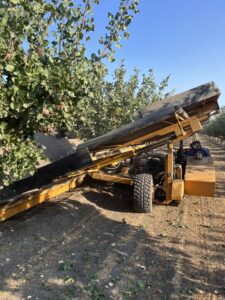
Q. What are you most hopeful about for the future of the tree nut industry?
I think with almonds we’re starting to turn the corner. We are just starting to recover from a 3-billion-pound crop, COVID-19 and all the logistical issues associated with shutting down the world. I’m not saying it’s going to be as profitable as it once was, but I think it’s going to be a profitable enterprise.
I’m real excited about pistachios. I know we’re going to have big crops, but pistachios are a nut that’s in high demand. The pricing seems very stable for now, and as I look ahead and see what the effects of SGMA might do to supply or quality, I think we’re going to be in a sweet spot for a while, provided there’s no big economic shocks. But I really like what the industry’s doing.
Q. What would you say needs to happen to put the tree nut industry on its best possible trajectory for the next few years?
I think no matter what nut it is, you have to export 70% of what we produce. So, I think what we have to do is continue building global demand for nuts. If I was in charge, that’s where I’d spend the bulk of my money. I’m not a trained marketing person, but I think we have to refocus and re-evaluate to make sure all our efforts in global marketing are the best practices and quantifiable, and we focus on that.
If I was in charge, the second thing that I would tell farmers and farmer organizations to do is you need to invest in advocacy because we need to tell our story. I don’t care what part of agriculture you’re in, our neighbors, leaders and legislators must hear our story. Every day, society becomes more distant in understanding where food comes from and what it takes to produce it.
When you think about how many pistachios and almonds we ship a year, they’re a speck on the wall in the total trade picture. So, who’s going to tell that story? Well, we have to tell our story because it doesn’t register on any scale.
Q. What do you think are the biggest assets of the California tree nut industry?
Obviously, all the nuts are a protein-dense, nutrient-dense product, and when you think about food products that you have to move all around the world, what better form to move it in? Once we process them, they don’t go bad. You can store them for a long time, they can get on shelves, and provided they’re affordable, they’re a really good way to get protein to certain parts of the world that don’t have it, that need it.
Q. As somebody who got into farming without having a family background in it, what advice would you have for somebody wanting to get into farming tree nuts today?
You know what President Trump says about running for office? Don’t do it. Seriously, today is exceptionally tough. There are usually three ways: Inherit it, marry into it, work really hard.
With the uncertainty of the effects of SGMA, banks are more timid today than ever for new entries. Perhaps you can look at leasing or owners that will carry a note. Right now, land values and crop values are changing, and farmers are getting older. There may be some opportunity during these times for someone who works hard and is willing to take great risk.
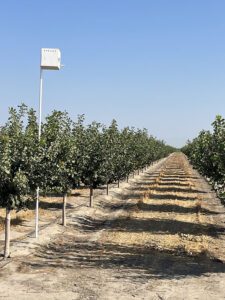
Q. What advancements do you see having a big impact on the future?
I like to think of myself as an early adopter, but I haven’t used [artificial intelligence] yet. I don’t know how to use AI. I haven’t spent the time. I was just out trying to find gopher holes that were leaking from an alfalfa field into my almonds, so I was on the end of a shovel for about three hours before this, so I haven’t gotten rid of that tool yet to get on to the next tool. But I think as things get more and more expensive and labor tightens, you’re going to see more automation.
Back to AI, I think we may be able to use AI to help us solve problems. Perhaps we will be able to use the technology to compile information to help us make decisions related to yields, pesticide use and MRLs, new best practices and water management.
There is this laser technology for weeding that may have some applications in certain conditions. You get tired of spending money on herbicides that don’t do anything, so I would be willing to invest in or be a grower partner in some equipment, but they’re not there yet. I think we see some advances in that.
Farmers are innovative and resilient. Economics will drive invention and innovation so we can continue to grow the most bountiful and safest food in the world.







